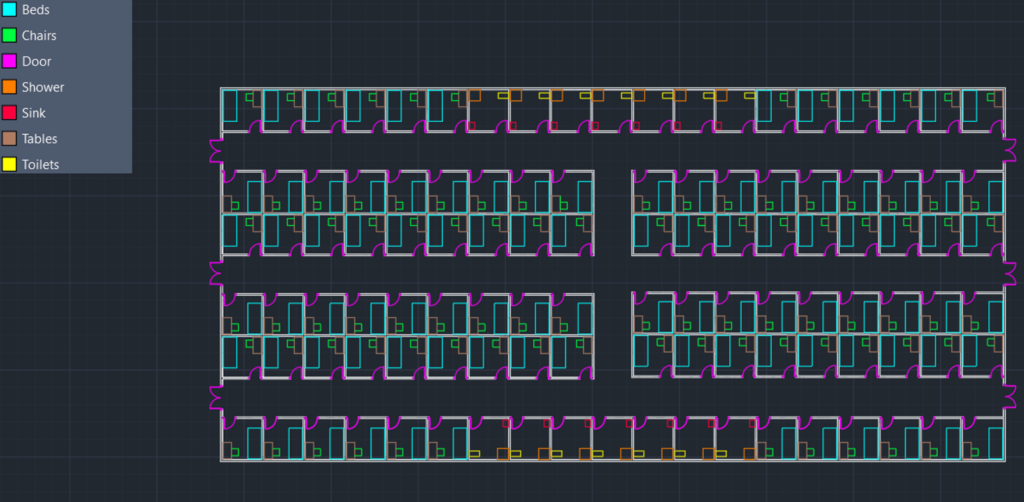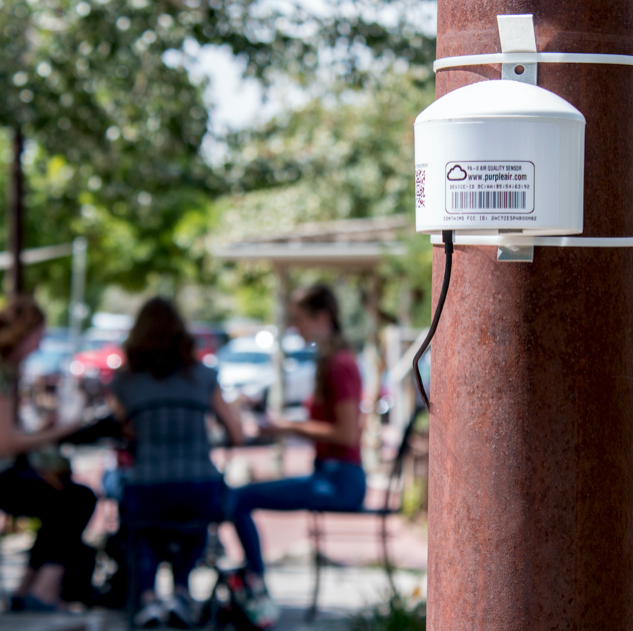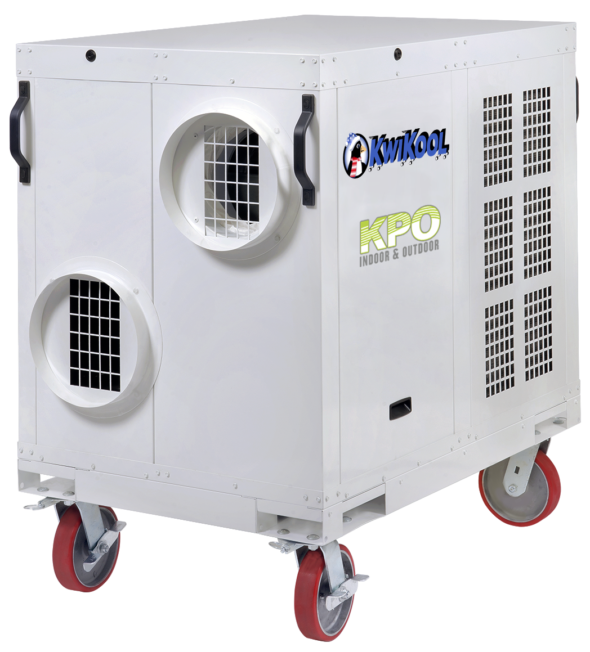Project Category: Multidisciplinary

Our Project
As CO2 emissions and global temperatures continue to rise, the occurrence of wildfires and their severity have been seen to increase as well. The 2014 wildfires in the Northwest Territories were Canada’s largest fire in terms of hectares burned. These fires caused roughly $56 million Canadian dollars in damages, destroying over 3.4 million hectares of land [1]. One of the most detrimental effects of these wildfires were the increased health complications it created for local communities, including respiratory and cardiovascular disease. Stanton Territorial Hospital experienced twice as many hospital admissions for asthma related problems during the summer of 2014, and it is expected that these health complications will continue to rise [2].
To alleviate the effects of poor air quality during wildfire events, our team designed three solutions to create clean air shelters that can be rapidly deployed in communities in critical condition. The two communities of Norman Wells and Tulita were chosen to model each design solution, as they were considered most at-risk due to their remoteness and proximity to historical wildfires. The first solution is to provide communities with a mobile air quality response unit. This would include equipment and materials such as air filters, portable air purifiers, and face masks that could be airlifted to remote communities to transform any building into a clean air shelter. The second solution is to construct large, modular, temporary tent structures with a quick set-up time for those at risk to live in during wildfire events. These air shelters would have an overall footprint of 16,565 sq ft, and consist of 96 bedrooms and 14 bathrooms. The shelter would also see the inclusion of its own HVAC system, as well as additional equipment that would be useful in an emergency event. Finally, our third solution is to design modifications to existing public buildings to create permanent air shelters. These modifications would include air curtains, high rated filters for air intakes, and methods to seal off areas where air may enter the building.
The mobile air quality response unit would cost approximately $80 thousand dollars, the temporary structure would cost approximately $1 million dollars, and the modifications to existing public buildings would cost approximately $30 thousand dollars per community. Using all three design solutions in tandem would minimize the adverse health effects of wildfire smoke, however due to cost limitations this may not be possible. The implementation of any one or combination of two solutions would still likely have a large positive impact on health when compared to the status quo.
Our Team
| Jaeyun Chung | Jamil Jama | Brent Lidfors | Christum Bilbao |
| Energy Engineering | Energy Engineering | Energy Engineering | Energy Engineering |
Design Details
How does our design address practical issues?
Wildfires in the Northwest Territories have seen an increase of proliferation and severity over the past two decades, and reached record high damages during the summer of 2014. During these wildfire events, the concentration of particulate matter (PM2.5) in the air reaches critical levels that are dangerous to human health. Recent studies have shown that poor air quality is strongly associated with respiratory, cardiovascular, and cerebrovascular diseases [3]. These diseases are three of the leading causes of death in the Northwest Territories [4], and therefore it is in the interest of this project to reduce the exposure of PM2.5 to individuals at-risk of such diseases. Currently, many of the buildings in the remote communities of the Northwest Territories are not equipped with the necessary level of air filtration to mitigate PM2.5 levels significantly. In addition to this, many of the communities are also only accessible during the winter via ice roads and therefore cannot have large vehicles transport equipment during the summer at the height of wildfire incidence. Wildfire events can also occur and spread rapidly, and thus our wildfire preparedness plan must be able to be deployed in a very short timespan.
Age-Standardized Mortality Rate by Leading Cause of Death (Per 100,000 Population) in NWT – Year 2000 – 2020

Our design project aims to provide those at risk of adverse health effects with clean air shelters with cost, deployment speed, and efficacy in consideration. Each of our three design solutions intend to target time periods of importance, as well as everyday activities:
- The mobile air quality response unit is designed to cover the time between wildfire incidence and set up/installment of the temporary tent and modifications to public buildings.
- The temporary tent provides space for those at risk to sleep or spend time privately in.
- The modifications to public buildings allow for communal spaces, as well as areas to cook and eat.
It is important to keep in mind that the development of adverse health effects is time sensitive, and therefore use of any individual or combination of design solutions would still provide an overall benefit. Each of these designs uses simple, lightweight, and compact materials and equipment to ensure quick deployment time, reduce costs, and meet logistic requirements.
What makes our design innovative?
Our design aims to deliver a rapidly deployable clean air shelter that can be delivered by air to remote communities at a minimal cost. The team also explored alternative modifications of HVAC systems for existing structures within the community that could act as a permanent emergency air shelter, and also looked into overarching strategies that could help communities be better prepared for wildfire conditions. Our design investigates multiple “what-if” situations and risks, considering a breadth of possibilities due to the unpredictable nature of wildfire proliferation.
What makes our design effective?
Our team’s design solutions were created to provide cost effective solutions that can be set up quickly, a feature that is especially important in remote communities where there can be many challenges to the transportation of equipment. The modular nature of our tent design allows for easier delivery to site and can be transported by air in communities where road access is difficult or unavailable. The design of the temporary tent structure, as well as choice of materials and equipment were selected to minimize cost while ensuring the efficacy of our clean air shelter options. We used quantitative analysis to calculate the requirements of HVAC systems, as well as qualitative analysis to choose optimal tent materials, design living spaces, and consider options that would be necessary to ensure protection from wildfire smoke at all times.
How did we validate our design solution?
Based on the Canadian Ambient Air Quality Standards (CAAQS) and the Guideline for Ambient Air Quality Standards in the NWT, the maximum acceptable level of particulate matter 2.5 (PM2.5) concentration is 28 μg/m3. This requirement was utilized, in conjunction with ASHRAE Standard 62.1 from the American Society of Heating, Refrigerating and Air-Conditioning Engineers (ASHRAE) and ASTM Standard D6245 the American Society for Testing and Materials (ASTM) to verify that clean air requirements are met – through the use of MERV 13 air filters – as well as the requirements for air circulation.
ASHRAE Standard 62.1-2019 – Ventilation for Acceptable Indoor Air Quality

ASTM D6245-18 – Using Indoor Carbon Dioxide Concentrations to Evaluate Indoor Air Quality and Ventilation


The floorplan of the temporary tent structure was designed to be compact and simple to construct, while maintaining overall safety. Due to the nature of use of these structures, it was decided that fire safety precautions were an elevated concern. Therefore wider hallways and multiple exits were integrated to maximize means of egress. Materials and equipment for the temporary tent structure were chosen based on both qualitative and quantitative analysis. This consisted of choosing options that were cost effective, verified the safety of inhabitants, and ensured the structure’s overall efficacy in providing a clean air space. For the tent fabric, it was decided to use PVDF polyester (Kynar®) due to its flame spread and smoke development ratings as well as its resistance to permeation of airborne contaminants. Several other options were considered for the tent’s fabric material, such as PVC polyester. However it was found that while PVC polyester was a cheaper option, it also had inadequate heat resistance and a higher permeation of particulate matter.
Feasibility of our design solution
Cost is a significant consideration of our design solutions. Costs for components, materials, and labor were averaged from online retailers as well as local services in Calgary. The following will describe each of our design solutions’ primary benefits and drawbacks:
Mobile Air Quality Response Unit
The mobile air quality response unit provides the most immediate impact on public health, as the materials and equipment in this component are lightweight and can be easily airlifted to remote communities on a short notice. This solution is less cost efficient than the permanent public building modifications, however it requires little set-up time. A drawback of this solution is its impermanence. The masks, air filters, and air purifiers have a very limited lifecycle, and would need to be disposed of after use. Consequently, this option would also result in a significant environmental impact if used too extensively. Therefore, the recommended best application for this option is for the short period between the incidence of a wildfire event, and the end of the set-up of a longer term solution. The masks and filters from this solution may be continued to be used after the tents or public building modifications are complete, to provide additional protection.
Temporary Tent Structure
The temporary tent structure provides a longer term solution than the mobile air quality response unit, as well as additional privacy over using public building spaces. This design solution would serve as a location for those at risk to sleep or spend time privately, covering a large portion of everyday life. This option is also the most costly by a large margin, and would require space to store materials outside of wildfire events to promote reusability and extend lifespan to minimize environmental impact. The temporary tent structure would best be implemented as the final step of an emergency wildfire response plan to maximize time coverage and comfort for the displaced population, or to alleviate crowding issues that may arise from using public buildings alone.
Modification of Public Infrastructure
The modification of public buildings is the most cost effective solution. Using the chosen buildings of the Mackenzie Mountain School in Norman Wells, and the Chief Albert Wright School in Tulita, occupants would be able to use the home economics rooms to prepare meals, which is otherwise not possible in the temporary tent structures. The use of these public spaces requires some set-up time unlike the mobile air unit, and would have less privacy than the temporary tents. The permanence of the air curtains and Corsi-Rosenthal Boxes would result in low environmental impact, except for the replacement of air filters. If used independently from the temporary tents, it could be possible for occupants to sleep within these buildings and portable space dividers could be implemented. This option could be used as the first long-term solution, and can provide initial protection from wildfire smoke as the situation develops.
Partners and Mentors
We would like to thank William Gagnon and Zoe Guile of the Government of Northwest Territories for sponsoring our project. We would also like to thank our academic advisor, Dr. Ke Du, as well as Dr. Budiman and our TA Mohsen Hassani for their guidance throughout this capstone project.

Photo Gallery
AutoCAD Design Sample of Tent

Map of NWT Communities Affected by Wildfires

Equipment



References
[1] The Canadian Press, “Northwest Territories bracing for wildfires after record 2014,” Macleans, 05-May-2015. [Online]. Available: https://www.macleans.ca/news/canada/northwest-territories-bracing-for-wildfires-after-record-2014/. [Accessed: 08-Dec-2021].
[2] “N.W.T.’s 2014 ‘summer of smoke’ led to twice as many emergency room visits for asthma: study,” CBC News, 13-Feb-2021. [Online]. Available: https://www.cbc.ca/news/canada/north/2014-summer-of-smoke-emergency-room-asthma-cases-1.5906308. [Accessed: 08-Dec-2021].
[3] K. K. Lee, M. R. Miller, and A. S. Shah, “Air Pollution and Stroke,” Journal of Stroke, vol. 20, no. 1, pp. 2–11, Jan. 2018.
[4] “Table: 13-10-0800-01 Deaths and mortality rate (age standardization using 2011 population), by selected grouped causes,” Statistics Canada, 09-Mar-2017. [Online]. Available: https://doi.org/10.25318/1310080001-eng. [Accessed: 08-Dec-2021].
